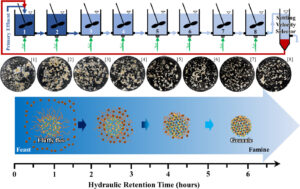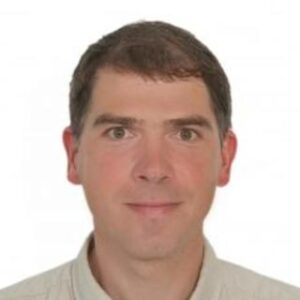Environmental engineers, local governments, and public policy leaders confront numerous challenges commonly faced at wastewater treatment facilities – increased usage, managing ebbs and flows (known as feast and famine in the industry) and often older, less effective sedimentation tanks — usually set near a watershed which limits space for additional construction. Facing these constraints, molecular biologist and Mason Associate Professor Benoit Van Aken wanted to create a team to look carefully at how the use of a newer procedure, the use of aerobic granulation to speed sedimentation, might increase the effectiveness of these plants. When Van Aken learned about the 4-VA Collaborative Research Grants, it spurred him to seek funding which could bring his plan to fruition.
The grant could, Van Aken posited, build a connection between the Potomac Environmental Research and Education Center (PEREC) in Woodbridge, where Van Aken’s lab is located, and the Occoquan Watershed Monitoring Laboratory (OWML) in Manassas where the lab of Dr. Zhiwu (Drew) Wang, of Virginia Tech, is located. Wang’s research focuses on biological engineering for wastewater treatment and the two centers could create a partnership as the OWML is responsible for management of water quality in the Occoquan watershed and the PEREC, located a few miles from the Occoquan Reservoir, is engaged in restoration of Potomac River and the Chesapeake Bay watershed. Wang’s lab is equipped with pilot reactors and could generate bacterial material for the molecular analyses. Van Aken’s lab is equipped for DNA/RNA extraction and analysis, and sequencing library preparation, which could provide the tools to help understand the microbiology and functions of microbial communities developing in wastewater treatment systems.
Importantly, the two labs are located within an easy distance of the Prince William County wastewater treatment facility in Centreville, making it easy for the team to access sludge samples to for the research.
With the 4-VA@Mason grant secured, Van Aken got to work with his team. Trips were made to the Centreville plant to obtain batches of aerobic granules. Van Aken initially gave some of the sequencing studies to undergraduate students, but then hired Alison Gomeiz, a chemistry student studying for her master’s degree. Van Aken met (via Zoom during the pandemic) with Gomeiz regularly to review her tests and consulted with partner Wang frequently to get his input on the testing. Their goal was to assess what changes in the microbial community composition in aerobic granules compared to conventional microbial flocs.
Van Aken explains, “For more than a century, wastewater treatment has been based on bacterial cells or small cell aggregates dispersed in wastewater — activated sludge. Aerobic granulation exploits the capability of bacterial cells to co-aggregate into large, dense, spherical granules, which present remarkable advantages over dispersed cells for wastewater treatment, which can speed sedimentation and the removal of the biomass from the bottom of the tank.”
Because aerobic granulation has been successfully applied only in sequential batch reactors (SBRs), while most wastewater treatment plants operate in continuous flow reactors (CFRs), it was important to assess what changes happened in both the feast and famine conditions. Aerobic granulation is estimated to have to potential to reduce energy consumption in wastewater treatment by more than 60%.
 Essentially, the team identified the changes associated with aerobic granulation. This provided the ability to predict the functionality of bacteria in the new reactor system that facilitated the aerobic granulation process. “There is a time where the bacteria received the hard water, that’s the feast conditions, where it receives a lot of nutrients. And we also studied the water when there is not much nutrient available — the famine phase,” says Van Aken. “We were able to predict when we can reduce the retention time, that means the time it needs for the particle to settle down at the bottom of the tank. That’s a big advantage.”
Essentially, the team identified the changes associated with aerobic granulation. This provided the ability to predict the functionality of bacteria in the new reactor system that facilitated the aerobic granulation process. “There is a time where the bacteria received the hard water, that’s the feast conditions, where it receives a lot of nutrients. And we also studied the water when there is not much nutrient available — the famine phase,” says Van Aken. “We were able to predict when we can reduce the retention time, that means the time it needs for the particle to settle down at the bottom of the tank. That’s a big advantage.”
Their work has already been disseminated in an article for Science Direct however, Van Aken says there is more work to be done. Thanks to the new relationship with the Wang lab, there many more opportunities ahead for this collaborative work.


